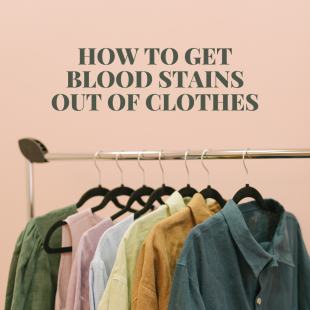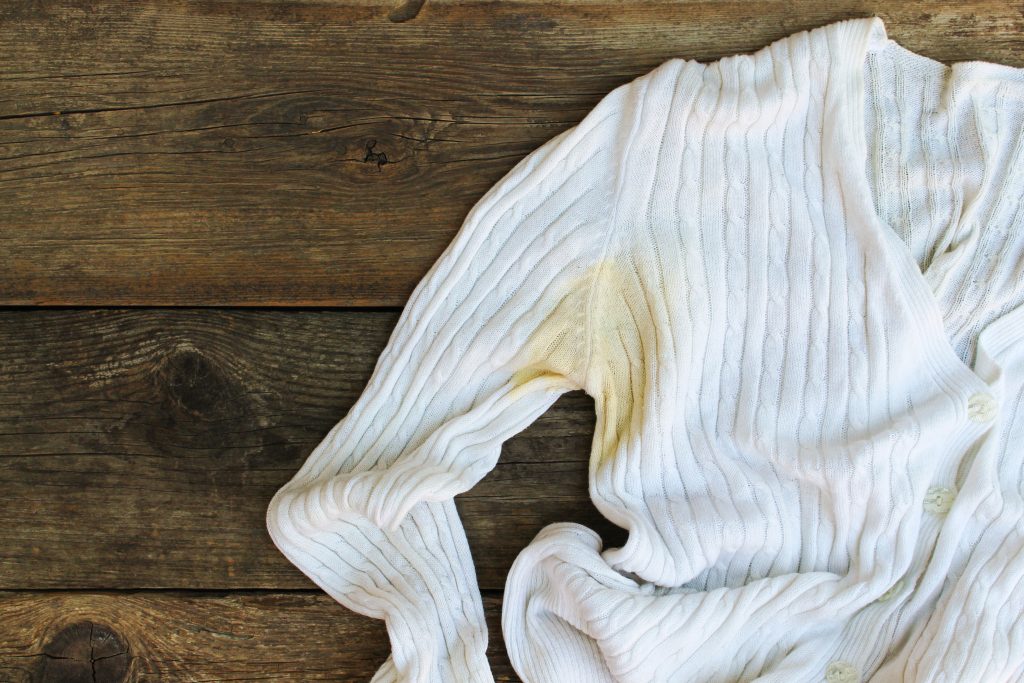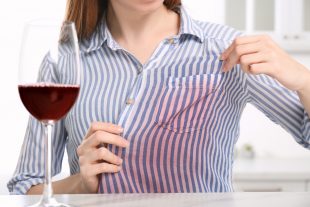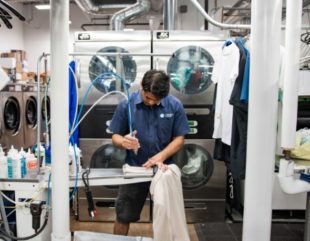 Get How-To's
Get How-To's
How To Get Blood Stains Out of Clothes
$3 Dry Cleaning Wednesday 1-4 PM with Coupon!
Read tips, tricks, and how-to’s on our Fabric of Life blog.
How-To's

Baking soda and hydrogen peroxide, white vinegar and lemon juice, or oxygen bleach are some of the most effective ways to lift yellow spots.
White clothes are a wardrobe essential, but they often come with one big challenge: yellow stains. These stains, particularly on the underarms of white shirts, are typically caused by a mix of sweat, deodorant buildup, and the natural aging of fabrics. While it might seem like these clothes are beyond saving, there are actually some effective techniques for tackling these stains at home. In this guide, we’ll cover a few tried-and-true DIY methods for removing yellow stains and help you decide when it’s time to seek out professional dry cleaning.
The number one cause of yellow stains is sweat. When you sweat, you leave behind proteins and enzymes that alter the color of your clothes. This is particularly noticeable in garments like white shirts where the underarms collect sweat throughout the day. The yellowing caused by sweat can be further exaggerated by certain deodorants. If your deodorant contains aluminum, more yellowing will occur due to a chemical reaction with the enzymes in your sweat which results in yellow stains.
Sometimes fabric type and quality have an impact on how prone a garment will be to yellowish stains. For example, take delicate fabrics and synthetic fibers which absorb and hold more sweat than water-resistant natural fibers. Not only does the fiber type play a role in how much yellowing will occur, but it also has effects on how easy these stains are to remove. Fabrics made from silk and polyester can be especially difficult to clean as the care labels often advise against harsh chemicals.
Many household ingredients can be used as a reliable cleaning process for yellow spots on white clothes including,
One widely used stain removal technique is using a mixture of baking soda and hydrogen peroxide. If you have read any of our other articles or any article on stain removal, you have likely come across this solution. This method is effective because it aids in the breakdown of enzymes, helping to remove them from your white clothes. A baking soda and hydrogen peroxide mixture is also beneficial in cases where yellowing is caused by aging.
To use this technique, follow these simple steps:
Another common bleach-free alternative stain removal method is using a mixture of white vinegar and lemon juice. The acidity in the lemon juice and vinegar helps to break down the enzymes left behind by sweat stains, allowing them to be effortlessly washed away.
To use this technique, follow these simple steps:
Oxygen bleach is one of the most effective ways to lift yellow spots and the good news is it can be used on delicate fabrics. Another name for Oxygen bleach is sodium percarbonate, a natural compound derived from plants that can pull sweat and yellow stains from white clothes.
To use this technique, follow these simple steps:
Choosing the right washing technique is just as important as the cleaning solutions themselves. Washing with care can ensure the stain removal techniques work effectively. For tough stains, use the hottest water that is safe for the fabric, as indicated on the care label. Hot water helps break down sweat and deodorant buildup, which are often responsible for yellowish stains.
Furthermore, some laundry detergents contain fabric softeners and enzyme-based stain removers that can help break down sweat stains. When dealing with delicate items or baby clothes, opt for a gentle, enzyme-based detergent to prevent damage while still removing yellow marks.
Sometimes yellow stains are too tough for DIY solutions. Other times, fabrics may be too delicate. When it comes to persistent stains, a professional dry cleaning can be an effective solution.
Professional dry cleaners often use enzyme-based stain removers and mild bleach solutions that work well on stubborn yellow stains. These advanced techniques ensure a reliable cleaning process that not only removes the stain but also maintains the garment’s original color and quality.
For delicate fabrics and baby clothes, professionals know how to treat these materials with tender care. This gentle approach helps prevent any potential damage to white garments and synthetic fibers, making dry cleaning an ideal choice for items that require special attention.
White clothing can also benefit from regular dry cleaning, and not only once it has become stained. Regular dry-cleaning helps maintain the brightness of white garments over time by preventing yellow stains from setting into the fabric. Additionally, it can prevent the accumulation of residues from sweat and deodorants that might otherwise create difficult-to-remove yellow spots.
Several factors should be considered when deciding whether DIY or professional dry cleaning is best for stain removal. These factors include the type of stain, the type of fabric, and your budget/need for convenience. Let’s break each of these down in detail to help you decide which approach fits your garment’s unique needs:
Yellow stains, like those caused by sweat which are protein-based, can be effectively treated with do-it-yourself techniques using household items such, as baking soda or white vinegar in some cases. However, for stains that resist fading despite home remedies, it is generally recommended to opt for professional stain removal services.
Professionals use specialized solvents and techniques designed to break down tougher stains, reducing the risk of damage to the fabric. When a stain is difficult or deeply set, trusting an expert with the cleaning process can yield the best results and preserve the fabric’s quality.
The type of fabric significantly affects your approach to stain removal. While sturdy materials like cotton and polyester blends can often withstand DIY cleaning methods, delicate fabrics, such as silk or wool, are more prone to damage. Synthetic fibers may also require careful handling to avoid permanent discoloration.
With that said, for fabrics that might be harmed by DIY methods, professional care is the best way to ensure preservation. This is because professional dry-cleaning ensures that delicate materials receive gentle treatment and that each fabric type is cared for correctly.
DIY stain removal is generally more affordable, relying on readily available household products like vinegar or baking soda. However, professional dry cleaning offers convenience and can be especially beneficial for garments with tough stains or those requiring special handling.
Dry cleaners also save time, especially when managing frequent or complex cleaning needs. The investment in dry cleaning can be worthwhile for items that hold sentimental value or are frequently worn as the cost is justified.
CD One Price Cleaners can offer real stain removal results. Our expert team is equipped with professional-grade stain removers that can treat natural fibers, synthetic fibers, and even delicate fabrics. With CD One Price Cleaner’s reliable cleaning process, you can return your white clothes to their brand-new state and prevent future yellowing, keeping them bright and white!
Check out CD One Price Cleaners today for expert stain removal solutions in Illinois, Indiana, Minnesota, and Missouri!
We think you may like
 Get How-To's
Get How-To's
How To Get Blood Stains Out of Clothes
 Get How-To's
Get How-To's
How to Remove Wine Stains
 Get Garment Guides
Get Garment Guides
The Science Behind Sweat Stains